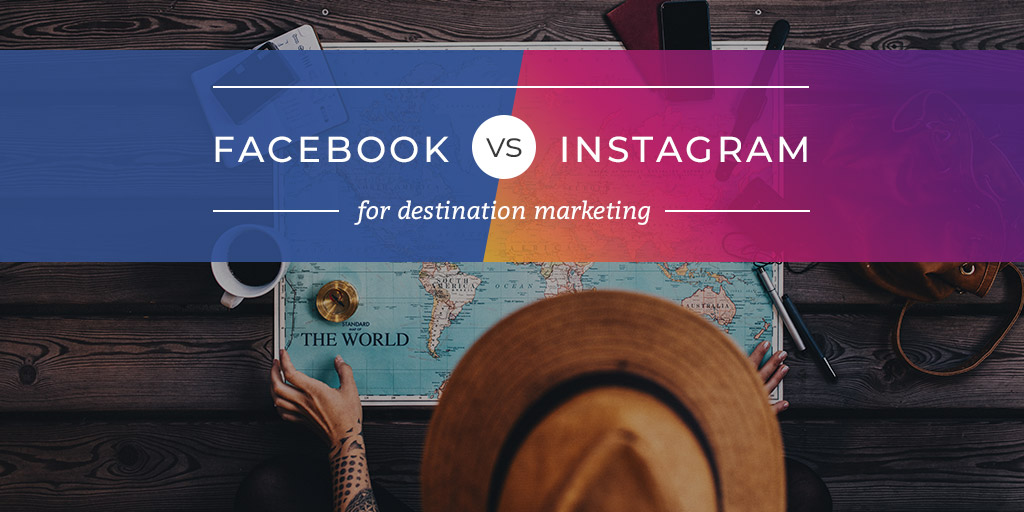 Written by
Logan Mayville
Written by
Logan Mayville
One of the questions we hear a lot from destination marketing organizations is: should I be advertising on Facebook or Instagram? Which one is better?

It’s a simple question, but the answer isn’t exactly straightforward.
You can run both Facebook and Instagram ad campaigns from Facebook’s platform, and they both offer targeting options to help you reach the right people. But which one will give you the biggest bang for your buck?
Before we answer that question, let’s take a quick look at some stats for each platform:
Facebook is the clear market leader among social networking sites:
- Daily Active Users: 1.49 billion
- Total Monthly Advertisers: 6 million
- 83% of adult women and 75% of adult men use Facebook
- 81% of 18-29 year olds use Facebook
- 41% of 65+ year olds use Facebook

But don’t discount up-and-coming Instagram. Instagram’s user base mushroomed in 2016, increasing its advertising potential:
- Daily Active Users: 500 million
- Total Monthly Advertisers: 2 million
- 39% of female and 30% of male internet users use Instagram
- 64% of 18-29 year olds use Instagram
- 10% of 65+ year olds use Instagram
As you can see, Facebook outpaces Instagram on all fronts, but that’s not surprising. Both platforms are growing rapidly, and Instagram’s advertising and usage numbers have skyrocketed in just the past year. The real question boils down to this: Where does your buyer persona spend their time and how can you use each platform’s unique features for your audience?
Here’s what you need to know..
Facebook Advertising Vs. Instagram Ads
Clearly, more people know and use Facebook—especially among older generations. If your target audience is older than 50, only Instagram isn’t going to cut it. Facebook also gives you more content options. You can post text, images, video, links—just about anything goes. There are also several different types of ad formats you can play around with such as carousel ads, videos, Messenger ads or even Facebook Stories or Slideshows.
But that doesn’t mean Instagram is never the best choice. Heavily-reliant on images and video, Instagram caters to a younger crowd. It’s a good choice if you’re targeting Millennials or the rising Generation Z. Instagram is better for sharing influencer content as well.
Instagram is also more “real-time” oriented than Facebook. Even if posts are scheduled in advance, users expect them to appear fresh, candid, and relevant—not like a traditional ad. Ads on this platform should use eye-catching images to reach people in the awareness stage.
Targeting Options
Both Facebook and Instagram offer a bucket load of targeting options, which makes it easy to reach specific buyer personas. Here are just a few of the ways you can target the right audience:
- Interests and Demographics—What have they expressed interest in?
- Engagement Habits—What content have they interacted with?
- Lookalikes—Who displays similar characteristics to your target audience?
- Current Customers—Who has already purchased from you or subscribed to your list?
- Retargeting—Who has already engaged with your brand and can you nurture those leads with additional relevant content?
Also keep in mind, Instagram is almost guaranteed to be a mobile view because very few people interact with the platform via desktop.
Campaign Objectives
Facebook pulls ahead a little in this category, but that doesn’t mean Instagram is short on options. Both channels offer objectives like:
- App engagement
- App installs
- Clicks to website
- Mass awareness
- Page likes
- Reach and frequency
- Video views
- Website conversions
Facebook also offers some additional campaign objectives including brand awareness, event responses, lead generation, and local awareness.
Additional Considerations
The bottom line is: which platform will reach your target buyer persona most effectively? Here are a few final considerations to keep in mind:
- Cost—We can’t give you an exact cost for Facebook advertising vs. Instagram ads, because cost depends on a number of different variables. However, you can manage costs by optimizing your audience based on demographics and relevance.
- Reach—Facebook’s larger user base means you’ll have the opportunity to reach more people with your ads. And Instagram’s smaller audience means you’ll need to change up your content more often.
- User Expectations—Users expect different kinds of content on Facebook and Instagram. If you don’t follow those norms, your ads will stick out like a sore thumb.
Instagram or Facebook?
Drumroll, please—test both! No one platform is best for every destination marketing organization or every customer all the time. You may have already been testing this without even knowing it. If you've ran Facebook ads with a connected Instagram account and chosen "All Placements" (which is the default setting), your ads have been shown on Instagram. To see their results vs. Facebook, use the "Breakdown" tool in Ads Manager and select "Platform" from the list of options. Choose where to spend your marketing dollars by getting to know your audience, learning where they hang out most, and testing ads on both platforms.
And then make your choice.
Once you’ve done that, you can have fun building and testing campaigns. And keep your eyes peeled for new developments on both Instagram and Facebook. You never know what Mark Zuckerberg is going to pull out of his hat next.
Let us hear from you! Do you prefer Facebook advertising or Instagram ads? Which one works best for your audience? Give us your thoughts in the comments!



